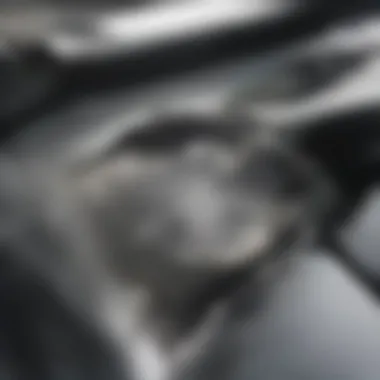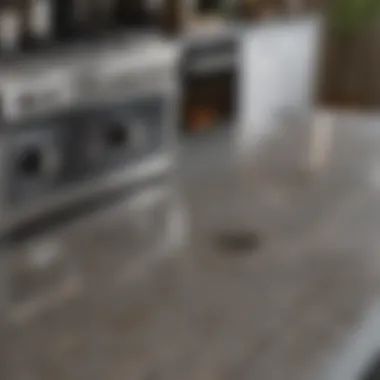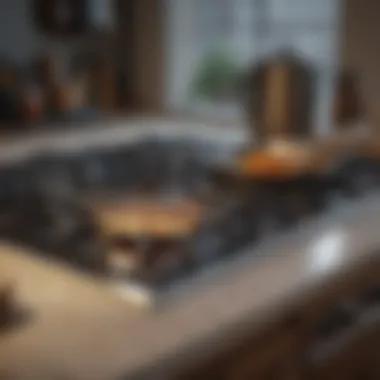The Ultimate Guide to Cleaning Solid Surface Stove Tops


Intro
Cleaning solid surface stove tops requires specific techniques and attention to detail. Many homeowners do not realize that improper cleaning can result in damage or unsightly stains. This guide aims to provide an in-depth look at how to properly care for these surfaces.
The relevance of this topic is significant for anyone who values the aesthetics and functionality of their kitchen. A well-maintained stove top not only enhances the visual appeal but also extends the lifespan of the appliance. In this article, we will explore various preparations, recommended cleaning agents, and essential maintenance tips, ensuring that your solid surface stove top remains in exceptional condition for years to come.
Understanding Solid Surface Stove Tops
The importance of understanding solid surface stove tops cannot be overstated. They have become a popular choice in modern kitchens due to their versatility and aesthetic appeal. Solid surface materials are a blend of acrylic or polyester resins and natural minerals, resulting in a durable, non-porous surface that is easy to clean. By grasping the essential elements of these stove tops, users can appreciate their benefits and considerations, leading to better maintenance and longevity.
Composition of Solid Surface Materials
Solid surface stove tops consist primarily of a polymer resin combined with powdered stone or mineral content. This unique blend provides not only a visually appealing surface but also robustness. The non-porous nature of these materials makes them resistant to staining and easier to wipe clean compared to other surfaces.
Furthermore, the seamless construction eliminates the potential for dirt and germs to accumulate in crevices. Solid surface materials can be fabricated into a variety of colors and styles, allowing for endless design possibilities in any kitchen. For instance, materials like Corian or Avonite are well-known options in this category.
Advantages of Solid Surface Stove Tops
There are a variety of advantages to using solid surface stove tops.
- Durability: They can withstand the daily wear and tear of cooking with little effort to maintain their appearance.
- Easy to Clean: They require no special products for cleaning. A mild detergent and a soft cloth are often sufficient to maintain their glossy finish.
- Repairable: Unlike traditional ceramic or glass, minor scratches can be sanded out, restoring the surface back to its original state.
- Versatile Design: Solid surface materials can be shaped to fit any kitchen design, making them suitable choices for both contemporary and traditional aesthetics.
Understanding these attributes is crucial for homeowners or enthusiasts in maintaining their kitchen’s value and appearance. By valuing the qualities of solid surface stove tops, users can ensure they make informed decisions about their kitchen choices.
Preparing for the Cleaning Process
Cleaning a solid surface stove top requires careful preparation to ensure the task is efficient and effective. This initial step is crucial. It sets the stage for a successful clean while also protecting the surface from potential damage. A well-prepared cleaning process allows homeowners to achieve a spotless finish without undue effort.
Gathering Necessary Supplies
Before commencing the cleaning, gathering all necessary supplies is vital. By having everything on hand, you prevent interruptions during the cleaning process. Gather items such as:
- Microfiber cloths: These are soft and will not scratch the surface.
- A non-abrasive sponge: Ideal for gentle scrubbing without causing damage.
- A soft-bristle brush: Useful for stubborn areas, but should be used carefully.
- Mild dish soap: A basic yet effective cleaning agent for day-to-day cleaning.
- White vinegar: This can help to break down grease and stains naturally.
- Baking soda: An excellent option for tackling tough spots and stains.
Having these items ready promotes efficiency and reduces frustration. It also ensures that you can tackle any mess, big or small, as it arises.
Safety Precautions to Consider
Safety is an often-overlooked aspect when cleaning kitchen surfaces. Adopting proper safety measures while cleaning solid surface stove tops can prevent accidents and injuries. Here are some key considerations:
- Temperature Awareness: Always ensure the stove is cool. Cleaning a hot stove can lead to burns and may also warp certain cleaning materials.
- Ventilation: Open windows or turn on range hoods to ensure good airflow, especially when using cleaning agents. This minimizes any harmful fumes.
- Protective Gear: Wear gloves if using strong cleaning solutions, as this can protect the skin from irritation.
- Check for Chemical Reactions: Be aware of what products you are mixing. Some combinations can create hazardous fumes.
Proper preparation is not just about cleanliness; it is about ensuring a safe and efficient workflow during the cleaning process.


Choosing the Right Cleaning Agents
Selecting the appropriate cleaning agents is crucial in maintaining the quality and appearance of solid surface stove tops. The right products serve to protect the surface from damage while effectively removing dirt and stains. More than just aesthetics, these choices influence the longevity of the materials used. Using unsuitable cleaners can lead to scratches, dullness, and often irreparable damage. Therefore, understanding the characteristics of both natural solutions and commercial products is essential for homeowners.
Natural Cleaning Solutions
Natural cleaning solutions are often favored for their safety and eco-friendliness. Many of these solutions use common household ingredients, making them both accessible and economical.
- Vinegar: Known for its acidity, vinegar can effectively cut through grease and grime. It's a gentle yet effective option on surfaces, leaving minimal chemical residue.
- Baking Soda: This agent acts as a mild abrasive which can remove tough stains without scratching the surface. When combined with water, it creates a paste ideal for spot cleaning.
- Lemon Juice: The natural acidity in lemon juice helps eradicate odors while providing a fresh scent. It can work similarly to vinegar in breaking down grime.
When using natural cleaners, it’s advisable to avoid excessive soaking. Prolonged exposure to liquids can weaken adhesives underlying the stove top material.
Commercial Products to Avoid
While there are many effective commercial cleaning products available, caution is necessary in selecting them. Some agents contain harsh chemicals that could damage solid surface stove tops.
- Abrasive Cleaners: Products like scouring powders or steel wool pads may remove stains but often scratch the surface in the process. For solid surfaces, it's crucial to avoid anything that could lead to micro-abrasions.
- Bleach-Based Cleaners: These may seem effective in eliminating stains but can discolor the stove top and degrade materials over time. The risks outweigh the benefits, especially for sensitive surfaces.
- Heavy-duty Degreasers: Though designed to tackle tough grease, many of these products are too harsh for regular maintenance and can weaken the surface finish.
It is important to read labels and follow the manufacturer's guidelines when selecting cleaning agents. Misusing cleaning solutions can lead to damage that may not be covered by warranties or return policies.
Understanding the right cleaning agents helps in preserving the aesthetic and functional quality of solid surface stove tops. By opting for safe, effective methods, homeowners ensure their kitchen surfaces remain in prime condition for years to come.
Step-by-Step Cleaning Techniques
Cleaning solid surface stove tops requires methodical approaches to ensure effective removal of dirt and grime. When done correctly, these techniques can vastly improve the appearance of your stove top and extend its lifespan. Understanding and implementing the right methods enable homeowners to maintain a hygienic cooking environment, which is crucial for both health and aesthetic appeal in the kitchen.
Initial Surface Wipe Down
Before diving into deeper cleaning, it is essential to perform an initial wipe down of the stove top. This process helps to remove loose food debris and dust, preparing the surface for subsequent cleaning steps. Begin by utilizing a microfiber cloth or a soft sponge dampened with warm water.
- Why Choose Microfiber? Microfiber effectively captures particles without scratching the surface.
- Damp Cloth Technique: A damp cloth lifts dirt better than a dry one, making it easier to surface clean.
Wipe the entire area gently, focusing on the knobs and edges where dirt often collects. Be thorough yet gentle to avoid damaging the surface. This step is fundamental because it acts as a prelude to more intensive cleaning processes.
Removing Stubborn Stains
Stubborn stains can be a significant source of frustration for many homeowners. However, targeted methods can effectively eliminate these blemishes. To address tough stains, fresh solutions are necessary. Here, various cleaning agents can be used successfully.
- Baking Soda Paste: Mix baking soda with a small amount of water to create a paste. Apply it to the stained area and let it sit for about 10-15 minutes. Baking soda acts as a mild abrasive.
- Vinegar Solution: An equal mix of white vinegar and water can serve as an effective stain remover. Spray it on the affected area, let it penetrate, then wipe with a clean cloth.
- Commercial Cleaners: If home remedies do not suffice, consider using a specialized cleaner such as Bar Keepers Friend. Follow the manufacturer's directions carefully to avoid damage.
After applying any of these solutions, scrub the stain gently with a non-scratch pad, ensuring you don’t apply excessive pressure that can lead to scratches. A careful approach helps in maintaining the integrity of the solid surface while restoring its shine.
Final Rinse and Drying Procedures


The final steps in cleaning involve ensuring that no residue remains on the surface. After removing stains and cleaning agents, a thorough rinse is crucial. Use a clean, damp cloth to wipe away any remaining product from the stove top.
- Follow up with a dry cloth to absorb any moisture left behind.
- This prevents streaks while enhancing the polished look of the surface.
Regular adherence to these step-by-step techniques not only ensures cleanliness but empowers homeowners to take control of the maintenance of their kitchen spaces. By establishing a routine that incorporates these cleaning methods, solid surface stove tops can remain visually appealing and functionally optimal.
Post-Cleaning Maintenance Tips
Once you have successfully cleaned your solid surface stove top, it is crucial to establish a routine for maintaining its appearance and functionality. Post-cleaning maintenance not only prolongs the life of your stove but also keeps it looking fresh and ready for use. This section will discuss the significance of a regular cleaning schedule and preventive measures that can help you avoid damage in the future.
Regular Cleaning Schedule
A consistent cleaning routine is vital for preserving the integrity of solid surface stove tops. Establishing a regular cleaning schedule allows you to catch dirt and stains before they become a significant problem. Typically, a weekly wipe down with a damp cloth and mild detergent can prevent grease buildup. Additionally, seasonal deep cleaning can help maintain the luster of your appliance.
Here are a few benefits of adhering to a cleaning schedule:
- Prevents Stains: Frequent upkeep prevents food particles from hardening and staining the surface.
- Enhances Longevity: Regular maintenance helps to ensure the materials remain strong and intact over time.
- Simplifies Cleaning: Staying on top of cleaning tasks minimizes the time and effort required during deep cleanings.
To incorporate this into your routine, you might consider using a wall calendar or an app that sends you reminders. Even an easily accessible note on your fridge can serve as a prompt.
Preventive Measures to Avoid Damage
Taking care of your solid surface stove top is not only about cleaning but also about being proactive to avoid potential damage. Here are some preventive measures that can help:
- Use Appropriate Cookware: Avoid using cookware with rough bottoms or those made of materials that are known to scratch the surface, such as cast iron. Opt for ceramic or stainless steel.
- Avoid Abrasive Cleaners: Strong chemical cleaners can corrode the surface. Instead, choose milder cleaning agents specifically designed for solid surfaces.
- Immediate Spill Cleanup: Wipe spills as soon as they occur. This will reduce the risk of permanent staining and make cleaning easier in the long run.
- Temperature Control: Sudden temperature changes can create cracks or affect the finish. Always be cautious of how hot cookware is when placing it on the stove.
** "The key to a long-lasting and attractive solid surface stove top lies in the commitment to proper maintenance practices."**
Implementing these simple yet effective practices can transform the way you interact with your kitchen, ensuring that it remains a pristine space for both cooking and entertaining. By embedding these tips in your cleaning routine, you will create an environment that not only looks appealing but operates efficiently as well.
Troubleshooting Common Issues
Every home chef encounters challenges with their kitchen surfaces, especially solid surface stove tops. Understanding how to troubleshoot common issues ensures that you maintain the aesthetic and functionality of your appliance. Identifying problems quickly can save time and money, and it enhances the overall cooking experience.
Dealing with Scratches
Scratches on solid surface stove tops are a frequent concern for many users. While these tops are designed to be durable, they can still sustain scratches from pots, pans, or even abrasive cleaning materials. Addressing these marks promptly is crucial to avoid deeper damage and maintain the surface's pristine look.
To effectively deal with scratches, consider the following steps:
- Assess the Depth: Determine how deep the scratch is. Light scratches can often be repaired easily, while deeper ones may require professional attention.
- Use a Non-Abrasive Cleanser: Choose a gentle, non-abrasive cleaner. Products like baking soda can be mixed with water to form a paste that helps in buffing out shallow marks.
- Employ a Soft Cloth: Apply the paste with a soft cloth or sponge, rubbing lightly in a circular motion. This method minimizes further scratching while promoting a smooth surface.
- Finishing Touch: After buffing, clean the area thoroughly with a damp cloth to remove any residue. This final wash ensures no abrasive material remains on the stove top.
If the scratch persists, you might want to consult a professional restoration service or look for specific repair kits tailored for solid surface materials. Failing to address scratches in a timely manner can result in more significant damage, compromising the overall look and functionality of the stove.


Addressing Discoloration
Another common issue with solid surface stove tops is discoloration. This can stem from various factors, including burnt food, heavy use of certain cleaners, or exposure to heat. Discoloration is not just an aesthetic problem; it can also indicate deeper issues with the material if left unaddressed.
To deal with discoloration effectively, consider these steps:
- Identify the Cause: Knowing what led to the discoloration can help in choosing the right cleaning method. For instance, food spillage might require a different approach than one caused by a cleaning product.
- Gentle Scrubbing: Start with a mild cleaner that is safe for solid surfaces. For stubborn stains, a scrub pad with its rough side can help gently lift the discoloration without harming the surface.
- Regular Maintenance: Implement a routine cleaning schedule to address stains before they set in. Regular cleaning not only helps combat discoloration but also maintains the overall longevity of the surface.
- Use of Solvents: For persistent discoloration, consider using a diluted solution of isopropyl alcohol or a non-abrasive cleaner designed specifically for solid surfaces. Always test any cleaner on a small, inconspicuous area before applying it across the surface.
By recognizing these common issues and acting promptly, you can ensure that your solid surface stove top remains in excellent condition. Protecting your investment in a quality stove relies on understanding its vulnerabilities and regularly addressing potential problems.
Environmental Considerations
The importance of environmental considerations in cleaning solid surface stove tops cannot be overstated. As we become more aware of our impact on the planet, choosing eco-friendly practices becomes not only a personal choice, but a necessity. This section delves into the significant elements that surround eco-friendly cleaning practices and product disposal methods, which play a vital role in long-lasting kitchen maintenance while ensuring we are minimizing our ecological footprint.
Eco-Friendly Cleaning Practices
Utilizing eco-friendly cleaning practices contributes to a healthier environment, both indoors and outdoors. Here are notable benefits of adopting such methods while cleaning solid surface stove tops:
- Healthier Air Quality: Traditional cleaning products can emit volatile organic compounds (VOCs) that deteriorate indoor air quality. Natural alternatives such as vinegar, baking soda, and lemon not only clean effectively but also reduce harmful emissions.
- Biodegradable Options: Making use of biodegradable products helps in minimizing the burden on landfills, reducing the amount of waste that contributes to pollution. Most natural cleaning ingredients break down safely and easily, unlike their synthetic counterparts.
- Safety for Kids and Pets: Eco-friendly cleaning supplies usually lack toxic chemicals found in conventional products. This provides peace of mind for households with children or pets, ensuring their safety during and after cleaning.
Some effective eco-friendly cleaning methods for solid surface stove tops include:
- Vinegar and Water Solution: Combine equal parts of distilled vinegar and water in a spray bottle. This mixture effectively cuts through grease and grime without leaving harmful residues.
- Baking Soda Paste: Form a paste with baking soda and water. Apply it to stubborn spots, let it sit, then gently scrub. This method is both gentle and effective for tough stains.
- Lemon Juice: Besides its pleasant scent, lemon juice acts as a natural disinfectant. You can use it to clean, deodorize, and remove grease spots effortlessly.
Disposing of Cleaning Products Responsibly
Proper disposal of cleaning products is an essential part of maintaining environmental integrity. Many traditional cleaning agents contain toxins that can contaminate water supplies and harm wildlife. Here are some key considerations:
- Read Labels: Always check product labels for specific disposal instructions. Some products may need to be taken to a hazardous waste disposal site rather than being thrown in regular trash.
- Avoid Flushing: Never flush cleaning products down the toilet or sink unless specifically allowed. This can lead to chemical buildup in sewage treatment facilities and affect water quality.
- Reduce and Recycle: Aim to use up cleaning supplies entirely or donate excess products that are still usable. This minimizes waste and can help others who may benefit from those items.
Adopting eco-friendly cleaning practices and ensuring the responsible disposal of cleaning products not only aids in maintaining your solid surface stove tops but also fosters a sustainable lifestyle. As you implement these practices, you contribute positively to the environment while enjoying a clean, safe kitchen.
The End
Cleaning solid surface stove tops is not merely an aesthetic activity; it reflects a commitment to maintaining a functional and inviting kitchen environment. The significance of keeping these surfaces clean extends beyond immediate visual appeal. It plays a crucial role in ensuring the longevity and performance of the stove top, which is an essential part of any modern kitchen.
Summary of Best Practices
In summary, the best practices for cleaning solid surface stove tops include:
- Regular Wipe-Downs: Daily cleaning with a soft cloth and mild cleaning solution prevents buildup and makes more thorough cleaning easier.
- Using Appropriate Cleaning Products: Opt for non-abrasive cleaners to preserve the surface finish, while avoiding harsh chemicals that could cause irreversible damage.
- Prompt Attention to Spills: Quickly address spills to prevent staining or damage, particularly for acidic substances.
- Implementing Preventive Measures: Use trivets for hot dishes and avoid pushing pots around the surface to minimize scratching.
These practices ensure your stove top remains functional and aesthetically pleasing over time.
Importance of Routine Maintenance
Routine maintenance is paramount in extending the life of your solid surface stove top. Regular attention not only keeps the surface visually appealing but also aids in identifying and addressing minor issues before they escalate into serious problems. Establishing a cleaning schedule, for example, could involve:
- Daily Cleaning: A quick surface wipe every day.
- Weekly Deep Cleaning: Involving more thorough cleansing and stain removal.
- Monthly Inspection: Checking for scratches, discoloration, or other potential issues to manage them proactively.
By maintaining a consistent cleaning routine, you ensure that the stove top will serve your kitchen well for many years. Routine upkeep is, thus, an essential component of effective stove top care.



